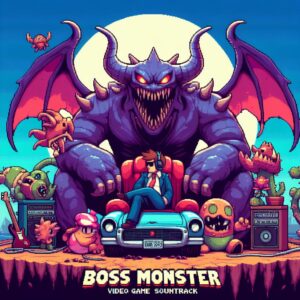Soundtracks provide emotional cues, enhance narrative elements, and create an immersive atmosphere. A well-crafted soundtrack can become as iconic as the visual elements of a game, evoking memories and emotions in players long after they have stepped away from the screen.
The Composition of “Boss Monster’s” Soundtrack
The composition of the soundtrack for “Boss Monster” pays homage to the sounds of the bygone era of 8-bit video games. The composers, possessing a clear understanding of iconic video game music, have carefully pieced together melodies that remind players of the classic gaming experience while simultaneously providing a fresh auditory perspective. This is achieved through the use of chiptune, a genre that employs synthesized electronic music produced by the sound chips of vintage computers, video game consoles, and arcade machines.
The composers of “Boss Monster” use a range of digital audio workstations and chiptune-specific software to emulate the textures and tones characteristic of early gaming systems like the NES or Game Boy. The sounds are typically created using simple waveforms such as square waves, triangle waves, sawtooth waves, and noise channels. These elements are fundamental to reproducing the distinct, pixelated sound that avid gamers instantly recognize and associate with the era that inspired “Boss Monster.”
The music in “Boss Monster” is not a straightforward replication of 8-bit music. The composers introduced modern production techniques, allowing for greater polyphony, dynamic range, and audio effects that were not possible on the actual hardware of the ’80s and ’90s. This creative liberty enriches the soundtrack, giving it a depth that enhances the game’s atmosphere without detracting from the vintage aesthetic.
Each track is designed to evoke the feel of an epic adventure, with catchy, memorable hooks that are easy for the player to recall. The harmonies support the melodies with a mixture of simplicity and complexity, just as the game itself balances easy-to-learn mechanics with strategic depth. This mirroring of game design within the music is a deliberate effort to ensure that every aspect of the player’s experience feels cohesive and interconnected.
In terms of structure, the soundtrack features an array of individual tracks that correspond to various aspects of the game, such as different levels or significant events. Each composition has a distinct identity yet maintains an overarching style consistent with the game’s theme. Transitional elements are smooth, ensuring that shifts from one musical piece to another are added to the evolving narrative that unfolds as a player progresses through the game.
Dynamic Music and Player Interaction
As players navigate through “Boss Monster,” making strategic decisions about how to construct their dungeons and defeat heroes, the music responds to their actions. This adaptive soundtrack serves several key purposes. It reflects the current state of play, changing tempo or volume to match the action’s pace and the intensity of the player’s experience. When the player encounters a particularly challenging hero or engages in a critical decision-making process, the music heightens in intensity, signaling the importance of these moments and enhancing the player’s focus and emotional investment.
During periods of planning or lower intensity, the music may take on a more subtle tone. This auditory cue allows for a cognitive shift, encouraging the player to consider their next moves carefully. The responsiveness of the music effectively underscores the ebb and flow of the gameplay, creating a coherent sensory experience that aligns with the player’s engagement level.
Upon successfully defeating an adventuring hero, the soundtrack may deliver a triumphant flourish, providing instant sonic gratification that complements the visual and gameplay rewards. This creates a multi-layered feedback loop that reinforces the player’s sense of achievement and satisfaction.
Each boss character comes with a musical theme that reflects their personality, and these themes can be modulated based on the player’s progression and performance. This personalization of music adds depth to player choices.
 The Role of Sound Effects
The Role of Sound Effects
When a player successfully plays a card, a distinctive sound follows, affirming the action. When a trap is activated or a hero takes damage, unique sounds accompany these events providing clarity and immediacy to the consequences of the player’s choices. This function of sound effects is necessary for delivering a responsive environment where players can rely on audio cues to understand the game’s mechanics and status without constantly relying on visual elements.
“Boss Monster” employs sound effects that resonate with the dungeon-themed setting of the game. The crumbling of walls, the echoes of distant dungeons, the specific sounds associated with different types of rooms, and the clash of hero versus monster—all these audio elements work together to create a more tangible and convincing game world. The purposeful selection and design of these effects aim to submerge the player in a world that feels alive and responsive to their presence.
Each hero’s arrival and the looming threat they present are accompanied by audio signals that help build tension and narrative progression. These cues offer insights into the potential challenges and victories that lie ahead, reflecting the unfolding story of the dungeon master they embody.
Ambient sounds create a consistent audio backdrop that contributes to the mood of the dungeon, whereas more pronounced effects are employed to indicate significant actions or changes within the game.
The success of “Boss Monster” can be seen in its cultural impact. The music of “Boss Monster” has grown beyond the game, with the soundtrack available for streaming and purchase, demonstrating the significance of its music in the gaming community. It serves as a testament to the importance of a game’s musical identity and its power to branch out into the everyday lives of its fans.